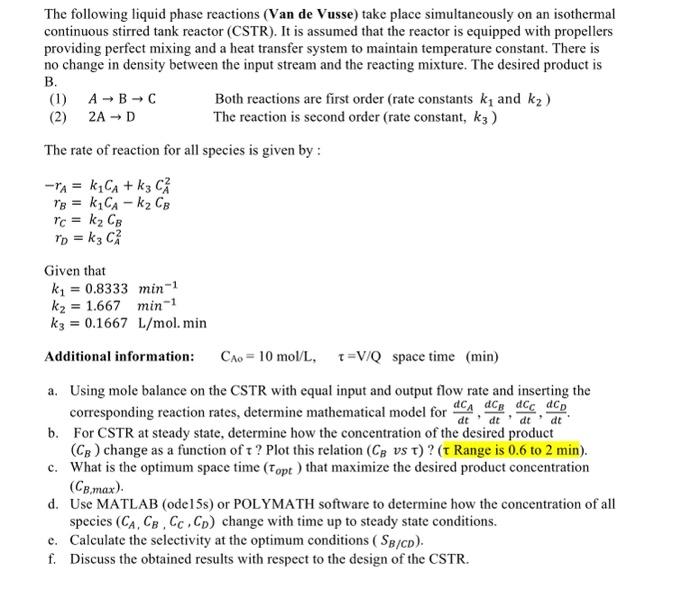Answered step by step
Verified Expert Solution
Question
1 Approved Answer
The following liquid phase reactions (Van de Vusse) take place simultaneously on an isothermal continuous stirred tank reactor (CSTR). It is assumed that the reactor
The following liquid phase reactions (Van de Vusse) take place simultaneously on an isothermal continuous stirred tank reactor (CSTR). It is assumed that the reactor is equipped with propellers providing perfect mixing and a heat transfer system to maintain temperature constant. There is no change in density between the input stream and the reacting mixture. The desired product is B. (1) (2) 2A D The rate of reaction for all species is given by : TB rc = rD = A B C k1CA + K3 C KCA - K CB = K CB k3 C Given that k k k3 Both reactions are first order (rate constants k and k) The reaction is second order (rate constant, k3 ) 0.8333 min- 1.667 min-1 0.1667 L/mol. min Additional information: CA. 10 mol/L, T=V/Q space time (min) dt dt' dt dt a. Using mole balance on the CSTR with equal input and output flow rate and inserting the corresponding reaction rates, determine mathematical model for CA dCB dCc dcp b. For CSTR at steady state, determine how the concentration of the desired product (CB) change as a function of t? Plot this relation (CB vs ) ? (t Range is 0.6 to 2 min). c. What is the optimum space time (Topt ) that maximize the desired product concentration (CB,max). d. Use MATLAB (ode15s) or POLYMATH software to determine how the concentration of all species (CA, CB, CC, CD) change with time up to steady state conditions. e. Calculate the selectivity at the optimum conditions (SB/CD). f. Discuss the obtained results with respect to the design of the CSTR.

Step by Step Solution
There are 3 Steps involved in it
Step: 1

Get Instant Access to Expert-Tailored Solutions
See step-by-step solutions with expert insights and AI powered tools for academic success
Step: 2

Step: 3

Ace Your Homework with AI
Get the answers you need in no time with our AI-driven, step-by-step assistance
Get Started


